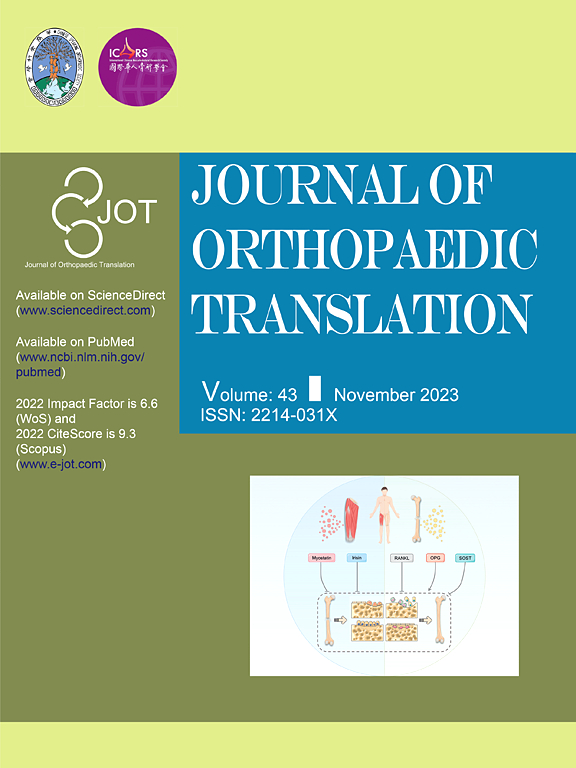Solute transport from synovial fluid to articular cartilage and subchondral bone at different stages of osteoarthritis in a live mouse model
IF 5.9
1区 医学
Q1 ORTHOPEDICS
引用次数: 0
Abstract
Objective
This study aims to (1) identify a simplified method to preserve sample integrity and maintain original fluorescence distribution; (2) assess the diffusivity of small and large molecules within articular cartilage (AC), calcified cartilage (CC), and subchondral bone (SB); and (3) investigate the changes in solute transport at various stages of osteoarthritis (OA) in a destabilization of the medial meniscus (DMM) murine model.
Methods
Fluorescent dyes of small and large molecules were injected into the knee joints of live mice. Joints were harvested and rapidly frozen immediately post-euthanasia. Optimal dye concentrations and dwelling times were determined through exploratory studies. Mice underwent either DMM or sham surgery and were evaluated at 2 and 8 weeks postoperatively. Relative fluorescence intensity was quantified within the AC, CC and SB, complemented by micro-CT, safranin O staining, and collagen II immunohistochemistry staining.
Results
The methodology successfully preserved sample integrity and original dye distribution. Fluorescent imaging revealed that small solute was mainly restricted by the tidemark, while large solute showed limited permeability in AC. Permeability of AC remained elevated in the DMM group at both time points. Increased permeability in CC and SB was observed only at 8 weeks post-DMM surgery, accompanied by reduced collagen II amount.
Conclusions
In live mice, the tidemark serves as a barrier to small molecule diffusion, while the cartilage surface restricts larger molecules; however, both structures exhibit increased permeability in OA. These findings advance the understanding of OA pathogenesis and suggest potential therapeutic targets related to cartilage permeability.
Translational Potential
The findings of this study advance the understanding of osteoarthritis pathogenesis by elucidating the role of solute transport alterations in cartilage and subchondral bone, thereby suggesting potential therapeutic targets aimed at modulating cartilage permeability to improve joint health in osteoarthritis.

骨关节炎不同阶段小鼠活体模型中滑膜液向关节软骨和软骨下骨的溶质转运
本研究旨在(1)确定一种简便的方法,既能保持样品的完整性,又能保持原有的荧光分布;(2)评估关节软骨(AC)、钙化软骨(CC)和软骨下骨(SB)内小分子和大分子的扩散率;(3)研究内侧半月板失稳(DMM)小鼠骨关节炎(OA)不同阶段溶质转运的变化。方法采用小分子和大分子荧光染料分别注入活体小鼠膝关节。在安乐死后,关节被摘取并迅速冷冻。通过探索性研究确定最佳染料浓度和停留时间。小鼠分别接受DMM或假手术,并在术后2周和8周进行评估。定量测定AC、CC和SB内的相对荧光强度,并辅以显微ct、红花素O染色和II型胶原免疫组织化学染色。结果该方法成功地保存了样品的完整性和原始染料分布。荧光成像显示,小溶质主要受潮纹限制,大溶质在AC中通透性受限。DMM组AC通透性在两个时间点均保持升高。仅在dmm手术后8周观察到CC和SB的通透性增加,并伴有II型胶原的减少。结论在活体小鼠中,潮纹对小分子扩散起屏障作用,而软骨表面对大分子扩散起限制作用;然而,这两种结构在OA中都表现出增加的通透性。这些发现促进了对OA发病机制的理解,并提出了与软骨通透性相关的潜在治疗靶点。翻译潜力本研究的发现通过阐明软骨和软骨下骨中溶质转运改变的作用,促进了对骨关节炎发病机制的理解,从而提出了旨在调节软骨通透性以改善骨关节炎关节健康的潜在治疗靶点。
本文章由计算机程序翻译,如有差异,请以英文原文为准。
求助全文
约1分钟内获得全文
求助全文
来源期刊

Journal of Orthopaedic Translation
Medicine-Orthopedics and Sports Medicine
CiteScore
11.80
自引率
13.60%
发文量
91
审稿时长
29 days
期刊介绍:
The Journal of Orthopaedic Translation (JOT) is the official peer-reviewed, open access journal of the Chinese Speaking Orthopaedic Society (CSOS) and the International Chinese Musculoskeletal Research Society (ICMRS). It is published quarterly, in January, April, July and October, by Elsevier.
 求助内容:
求助内容: 应助结果提醒方式:
应助结果提醒方式:


